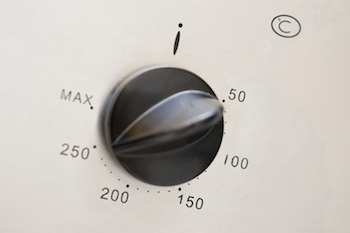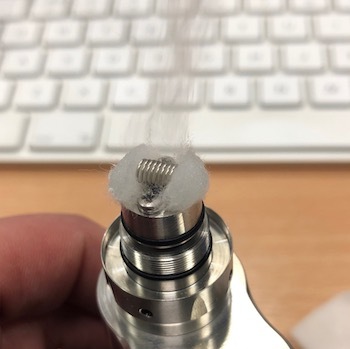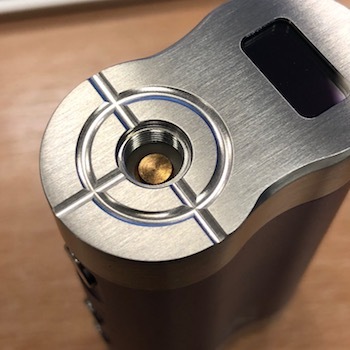Home Creme de Vape Blog Keith's take on temperature control
Keith's take on temperature control

I’ve been enjoying temperature control for over 4 years now and while it did take me a little time to get my head around it all, once I understood what’s going on with the technology and use that temperature control setting as a scale, not as an actual reference to a real temperature.
In 2014 Evolv was the first to market with their temperature control feature in the DNA40. As with all new tech I was eager to give it a try. It worked and did what it claimed to do albeit buggy and in need of some refinement, but I feel there was a bit of a flaw with the terminology used in setting your desired heat level. Sure, one can work out what the approx. temperature of a given wire should be based on the manufacturer’s specification for the resistance changes at different temperatures. This is called the TCR or temperature's coefficient of resistance. In simple terms this means that as a resistance target (the temperature setting) is reached on the TCR scale we can calculate the approx. temp of that wire based on the change in resistance from the room temperature's resistance.
But here’s where I think the terminology (but not the functionality) is flawed. We are not using an isolated straight piece of wire alone, we are using a coiled piece of wire attached by two screws or clamps with some sort of wicking material running down the middle with both liquid and air passing across it. Thus an actual temperature value is never going to be entirely accurate nor consistent - there are simply too many other variables at play when it comes to that "temperature" value.
Think about the difference between an oven and a hob (stove top). An oven usually has dials so you can set a desired temperature, this is easy for the oven's electronics to control because inside the closed space there is a thermostat (a device that measures the temperature) and this sensor is used to help regulate the power applied to the heating elements (coils) inside the oven to maintain that set temperature. Now take a look at the hob controls, these are normally dials or buttons that have a scale (ours goes from 1 to 10). There is a good reason why the hob has no temperature settings on those dials. There is usually no means for the electronics to measure the actual temperature of that particular heating element on the hob. This is also true with our vaping devices, there is no sensor to measure the actual temperature inside the atomiser's chamber. Therefore, I think it may have been better to use a scale from 1 to 10 or 1 to 20 for this setting on a TC device, but this is not the direction the market took and we have to understand the quirks of this technology and understand what’s actually going on.

Factors that play a role in the TC experience:
TCR value, every wire material type has a recommended value. This value is what the manufacturer of that wire states the resistance change is at a given temperature. In our vape devices we are using a max temperature coefficient of around 600F. The TCR value is how much change in resistance it takes to go from room temperature to a max of 600F. When you set your "temperature" on the device you are not actually setting a temperature, you are setting a resistance target on that TCR scale. Wire materials are not 100% consistent across all batches, all manufacturers etc etc... This is an approximation only and should only be used as a reference value to start with and most all devices on the market have the ability to set a custom TCR value, use this feature if you need to, do not rely on a wire type setup in the device from the factory as the default only. Personally I find that Ni200 having the highest change in TCR works best for temp control as there is a greater change in resistance as the wire heats up. Low TCR value wires such as stainless steel are not as stable and can fluctuate as the device attempts to work out the setting on very small changes which leads to a jumpy temperature that you can actually feel as you vape on some devices. The TCR value is based on the wire ITSELF, not all the other external factors such as liquid hitting it or air passing over it.
Wicking, this is a big one. As the temperature control device attempts to read the resistance change there is (or should be) a constant flow of liquid hitting the wire which in turn cools it down again and the device is able to hold a desired setting while you vape. If your wick/material or atomiser is not keeping up with the heating element the resistance climbs quickly and the power is reduced to maintain your target resistance (temp setting) and this leads to a weak vape -by design- keeping you from over heating the wick and getting a burnt taste from your juice. Too much liquid flow and things can go the other direction resulting in flooding and spitting as you actually get some boiling of the liquid. There is fine balance here between not enough liquid to the coil and too much. You just have to gain experience with this area and know your atomiser's ability to keep up with the wicking required in TC vaping. Don't be scared to experiment with different wick materials and amounts of wick you install in the coil. Some materials are better at keeping up than others, and what works for your friend may not work for you and your application. Every juice also has a different viscosity at different temperatures so bear in mind on warm days you may experience different wicking than you would on a cold day.

Air flow, another big factor. The amount of air passing across the coil cools it down significantly and lowers it's resistance. But air flow also has another role to play with an RTA. The amount of air pressure you apply by puffing on the device compared to the air hole size actually pulls liquid into the wicks at different rates. Every person puffs on their device with a slightly different pressure every time they vape and this can actually change though the day too. It's just not possible for a human to pull the exact same pressure on the mouthpiece every puff, all day long. As the market moves back to the mouth-to-lung style vape we are finding that the puff pressure has been decreasing a bit as the air hole sizes decrease (this was the norm 5 years ago). When you are vaping on an atomiser with large air holes and you are taking direct lung hits there is a lot of air passing the coil keeping it cooler and also pulling more liquid to the coil which can result in a warmer vape. With an MTL setup you may experience a weaker vape with TC as less air is passing the coil and less liquid is entering the chamber, you will need to experiment with the settings to get your desired vape, remember what I said before and think about temperature control as a sliding scale rather than a set of actual temperature values and bear this in mind when you are setting up your temp control device.
Connectivity. Every mod has a 510 connection on the top where you screw your atomiser down onto. This is a weak point for every temp control system. The threads are where the negative side of the circuit passes current. If your threads are dirty or wet with liquid (on either the mod OR the atomiser side) this can lead to an inaccurate temperature control experience. Make sure your threads and the 510 centre post on both the mod and atomiser are very clean and dry at all times to avoid issues of varying resistance (often called "Jumping"). If you knock or drop your device it's always a good idea to double check your settings and re-calibrate your coil to be sure everything is normal.

I hope this helps you understand a little better what may be happening inside your temp control device. Don't be too quick to jump to conclusions that your mod or atomiser may be faulty if your TC vape experience is not what you think it should be as there could very well be a small detail that's causing an issue for you. Don't be afraid to experiment with different wick materials, atomisers, or wire types. You may just find your perfect vape. What works for you may be completely different to what works for me. For temp control vaping, my favourite device is the Dicodes as it offers a stable and accurate experience. The room temperature resistance of the coil is locked by the user and the display on the firmware provides the ability to check at any point in time what the calculated resistance and temperature of the coil is (R/T menu) This gives me the ability to double check the coil at room temp to be sure nothing has changed or if it needs a recalibration, this is not a feature available on any other mod on the market (without hooking up to a PC and using software anyway).
Comments: 2
Is it possible for dirty contacts to cause the device to actually increase the power sent to the coil and therefore increase the temperature it is heated to? Or would any interference decrease the temperature? I am asking specifically regarding a Juul device.
Thank you




















